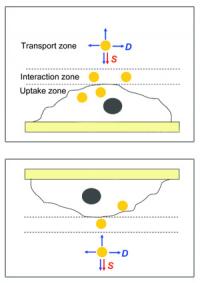Research results on nanoparticle applications and their toxicity depend on how well scientists are able to quantify the communication between the nanoparticles and cells, particularly the number of nanoparticles a cell can absorb. In clinical trials, cells are kept on the bottom of a dish, and a culture with nanoparticles is poured over them.
Younan Xia at the Washington University in St. Louis wondered if the direction of cells in gold nanoparticles would impact their uptake rate. Xia, the James M. McKelvey professor in the Department of Biomedical Engineering, said it is generally believed that the concentration of a suspension prepared in the lab would be consistent across the cell, including its surface.
 WUStL's Tests using Uprigght and Upside Down Cells
WUStL's Tests using Uprigght and Upside Down Cells
Tests were conducted using both standard and upside-down conditions with nanoparticles more than a certain size and weight. Nanoparticle concentrations close to the surface of the cell differed from those in bulk concentrate, increasing cellular uptake rates.
The research paper has appeared in the Nature Nanotechnology titled, ‘Studies on the cellular uptake of nanoparticles that have been conducted with cells in the upright configuration may have given rise to flawed and ambiguous data’.
The team designed a test that would help them ascertain whether settling impacted the concentration and the cellular uptake. Tests were conducted on gold nanospheres of three dimensions, nanocages of two edge lengths, and nanorods, some with surface coatings that absorbed serum proteins in solution, and some coated with a chemical that served as an antifouling agent. The cells were first incubated in the nanoparticle-bearing solution. The nanoparticles concentration was then determined spectroscopically. The number of particles absorbed by each cell was then determined based on the altered concentrations.
Xia says that earlier research has revealed that the cellular absorption of nanoparticles was based on the size, shape and surface coating of the nanoparticles. But the latest research has revealed that these properties related only to their impact on the ability of the nanoparticles to sedimentate and the speed at which they diffuse.
No changes were discerned in the upright and upside down configurations of the cells. But when heavier and bigger particles were used, sedimentation increased, while the upright cells absorbed more nanoparticles than upside-down one.